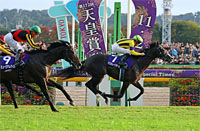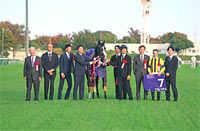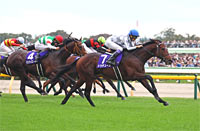Tenno Sho (Autumn) (G1) - Data Analysis
G1 race steeped in tradition that has been won by long line of era-defining runners
The six winners of the Tenno Sho (Autumn) since 2015 had all won a JRA G1 race since the previous year. Five of these (excluding 2018 winner Rey de Oro) triumphed in a domestic or overseas G1 race in the same year. Which runner will dominate this race that attracts champion-level performers? Let’s now analyze some features shared by successful runners in this race based on results over the last 10 years.
Focus on 4-year-olds and 5-year-olds
Of the 30 Top 3 finishers in the last 10 years, 29 were horses aged 5 or less. Meanwhile, horses aged 6 or above struggled with a Top 3 ratio of 1.8%. In other words, we need to discount horses aged 6 or above. [Table 1]
[Table 1] Performance by age (last 10 years)
| Age |
Performance
[1st-2nd-3rd-4th or lower] |
Win ratio |
Top 2 ratio |
Top 3 ratio |
| 3 |
0-1-1-9 |
0% |
9.1% |
18.2% |
| 4, 5 |
10-9-8-67 |
10.6% |
20.2% |
28.7% |
| 6 or above |
0-0-1-56 |
0% |
0% |
1.8% |
Incidentally, all 18 Top 3 finishers in the last six years were horses aged 4 or 5. If trends in recent years are anything to go by, we should lower our expectations of 3-year-olds. [Table 2]
[Table 2] Performance by age (last six years)
| Age |
Performance
[1st-2nd-3rd-4th or lower] |
Win ratio |
Top 2 ratio |
Top 3 ratio |
| 3 |
0-0-0-6 |
0% |
0% |
0% |
| 4, 5 |
6-6-6-38 |
10.7% |
21.4% |
32.1% |
| 6 or above |
0-0-0-29 |
0% |
0% |
0% |
Watch grade of, and finish in, previous race
The 30 Top 3 finishers in the last 10 years had all contested a JRA G1 or G2 race last time out. This suggests we should lower our expectations of runners that have not entered a JRA G1 or G2 race last time out. [Table 3]
[Table 3] Performance by previous race (last 10 years)
| Previous race |
Performance
[1st-2nd-3rd-4th or lower] |
Win ratio |
Top 2 ratio |
Top 3 ratio |
| JRA G1 race |
3-6-4-25 |
7.9% |
23.7% |
34.2% |
| JRA G2 race |
7-4-6-92 |
6.4% |
10.1% |
15.6% |
| Other race |
0-0-0-15 |
0% |
0% |
0% |
In addition, among runners that had contested a JRA G2 race last time out, those that had finished 4th or lower in that race achieved a Top 3 ratio of only 5.4%. It would therefore seem wise to focus on runners coming straight from a JRA G1 race and those coming off a strong performance in a JRA G2 race. [Table 4]
[Table 4] Among runners that had contested a JRA G2 race last time out, performance by finish in that race (last 10 years)
| Finish in previous race |
Performance
[1st-2nd-3rd-4th or lower] |
Win ratio |
Top 2 ratio |
Top 3 ratio |
| Top 3 |
6-3-5-39 |
11.3% |
17.0% |
26.4% |
| 4th or lower |
1-1-1-53 |
1.8% |
3.6% |
5.4% |
Runners starting in the outer brackets have fared poorly in recent years
All 12 Top 3 finishers in the last four years entered the race with the numbers 1-10. Runners with the numbers 11-18 performed well up to 2016, but runners starting in the outer brackets have struggled in recent years. [Table 5]
[Table 5] Performance by horse number (last four years)
| Horse number |
Performance
[1st-2nd-3rd-4th or lower] |
Win ratio |
Top 2 ratio |
Top 3 ratio |
| 1-10 |
4-4-4-27 |
10.3% |
20.5% |
30.8% |
| 11-18 |
0-0-0-19 |
0% |
0% |
0% |
Runners that have vied for top positions in previous major races have the edge
All 12 Top 3 finishers in the last four years had experience of “finishing 1st or 2nd or lower with a time difference of 0.1s or less with the winner” in a JRA G1 race. In other words, we should raise our expectations of runners that have either triumphed in a G1 race or finished right behind the winner in such a race. [Table 6]
[Table 6] Performance by experience of “finishing 1st or 2nd or lower with a time difference of 0.1s or less with the winner” in a JRA G1 race (last four years)
| Experience |
Performance
[1st-2nd-3rd-4th or lower] |
Win ratio |
Top 2 ratio |
Top 3 ratio |
| Yes |
4-4-4-24 |
11.1% |
22.2% |
33.3% |
| No |
0-0-0-22 |
0% |
0% |
0% |
Mixed performance by runners that had contested previous race in front position
Of the 12 Top 3 finishers in the last four years, 8 had contested a domestic race last time out and had been positioned 6th or lower when passing the 4th corner in that race. Conversely, runners that had been positioned 5th or higher struggled somewhat with a Top 3 ratio of 14.3%. In other words, we need to discount runners that have contested their previous race in front position. [Table 7]
[Table 7] Among runners that had contested a domestic race last time out, performance by position when passing the 4th corner in that race (last four years)
| Position when passing the 4th corner in the previous race |
Performance
[1st-2nd-3rd-4th or lower] |
Win ratio |
Top 2 ratio |
Top 3 ratio |
| 5th or higher |
1-0-3-24 |
3.6% |
3.6% |
14.3% |
| 6th or lower |
3-4-1-21 |
10.3% |
24.1% |
27.6% |
In addition, among the four Top 3 finishers that had contested a domestic race last time out and had been positioned 5th or higher when passing the 4th corner in that race, three had experience of “finishing in the Top 3 and ranking 6th or lower in the estimated time over the final three furlongs” in a G1 race held at Tokyo Racecourse since the previous year. If any of this year’s runners come with this kind of record, we should not underestimate them even if they have contested their previous race in front position. [Table 8]
[Table 8] Among runners that had contested a domestic race last time out and had been positioned 5th or higher when passing the 4th corner in that race, performance by experience of “finishing in the Top 3 and ranking 6th or lower in the estimated time over the final three furlongs” in a G1 race held at Tokyo Racecourse since the previous year (last four years)
| Experience |
Performance
[1st-2nd-3rd-4th or lower] |
Win ratio |
Top 2 ratio |
Top 3 ratio |
| Yes |
1-0-2-3 |
16.7% |
16.7% |
50.0% |
| No |
0-0-1-21 |
0% |
0% |
4.5% |
Seek out the winner!
Body weight a key point to watch
The last 10 winners had all contested a domestic race last time out and weighed in at 480kg or more in that race. The last runner to win the Tenno Sho (Autumn) after entering the previous race with a weight below 480kg was Buena Vista in 2010. This suggests we should lower our expectations of lighter horses.
In addition, the last 10 winners were all 4-year-olds or 5-year-olds, and had contested a JRA G1 or G2 race in their previous race. The last runner to win the Tenno Sho (Autumn) that was not a 4-year-old or 5-year-old, was 8-year-old Company in 2009, and the last runner to win the Tenno Sho (Autumn) coming from a race other than a JRA G1 or G2 race, was Agnes Digital in 2001 (previous race was Mile Championship Nambu Hai). This suggests we should also take into consideration the trends shown in Tables 1, 2 and 3. [Table 9]
[Table 9] Winners’ performance by body weight in previous race, age and previous race (last 10 years)
| Year |
Winner |
Body weight in previous race |
Age |
Previous race |
| 2011 |
Tosen Jordan |
486kg |
5 |
Sapporo Kinen (G2) |
| 2012 |
Eishin Flash |
494kg |
5 |
Mainichi Okan (G2) |
| 2013 |
Just a Way |
498kg |
4 |
Mainichi Okan (G2) |
| 2014 |
Spielberg |
508kg |
5 |
Mainichi Okan (G2) |
| 2015 |
Lovely Day |
490kg |
5 |
Kyoto Daishoten (G2) |
| 2016 |
Maurice |
510kg |
5 |
Sapporo Kinen (G2) |
| 2017 |
Kitasan Black |
542kg |
5 |
Takarazuka Kinen (G1) |
| 2018 |
Rey de Oro |
484kg |
4 |
All Comers (G2) |
| 2019 |
Almond Eye |
484kg |
4 |
Yasuda Kinen (G1) |
| 2020 |
Almond Eye |
488kg |
5 |
Yasuda Kinen (G1) |
(Masaya Ibuki)
|


















